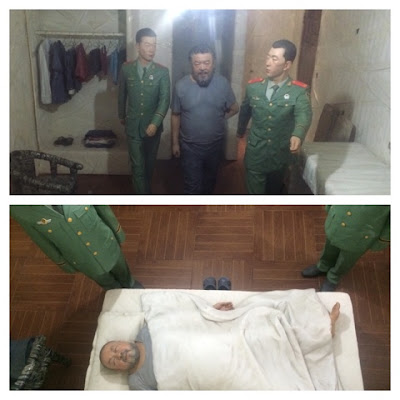At every turn there is something beautiful, thought-provoking and challenging. Ai's signature large-scale work, coupled with wonderful curating which allows you to walk around, through and under the installations, means that you can really immerse yourself in the exhibition. You can find one-metre cube versions of much smaller precious objects made of crystal, tea, or intricately-carved wood, or disparate items such as sex toys and human remains reworked in different materials.
In 'Marble Stroller', the worker-bee-like segments of marble grass evoke his famous sunflower seeds, all similar but individual. The stroller, and the petrified surveillance camera, represent a chilling encounter when Ai Weiwei was out with his young son and challenged a man photographing them. Weiwei took the memory card from the man, who claimed to be a tourist; checking it later at his studio, he found hundreds of images of his child.
'Dropping a Han Dynasty Urn' is here, along with 'Coloured Vases', a group of Neolithic vases (or are they?) destroyed/transformed by industrial paint. This, for me, was perhaps the least engaging part of a magnificent exhibition - possibly because the rest is so raw and visceral, this paled by comparison. The questions of value, authenticity and art are interesting but they are ongoing and I feel if they had been exhibited separately they may not have been immediately identifiable as his work; I didn't feel powerfully drawn to these in the same way as the rest of the rooms.
In 'Marble Stroller', the worker-bee-like segments of marble grass evoke his famous sunflower seeds, all similar but individual. The stroller, and the petrified surveillance camera, represent a chilling encounter when Ai Weiwei was out with his young son and challenged a man photographing them. Weiwei took the memory card from the man, who claimed to be a tourist; checking it later at his studio, he found hundreds of images of his child.
'Dropping a Han Dynasty Urn' is here, along with 'Coloured Vases', a group of Neolithic vases (or are they?) destroyed/transformed by industrial paint. This, for me, was perhaps the least engaging part of a magnificent exhibition - possibly because the rest is so raw and visceral, this paled by comparison. The questions of value, authenticity and art are interesting but they are ongoing and I feel if they had been exhibited separately they may not have been immediately identifiable as his work; I didn't feel powerfully drawn to these in the same way as the rest of the rooms.
The opposite is true of 'Straight'. This is my absolute favourite section of the exhibition; by which I mean, it brought me close to tears. 'Straight' is a response to the Sichuan earthquake in 2008 in which over 5,000 children died as a result of shoddily-built schools collapsing; film footage shows distraught parents attempting to resuscitate their lifeless children amid the wreckage.
The names of the dead - originally not released by the Chinese authorities - line the walls in bare chart form along with their dates of birth, while in the centre of the room a huge undulating row of rusted metal rods echoing the seismic activity graph of an earthquake, or the wave itself. These are the cheap rebars used to reinforce the concrete in the schools (there is a suggestion that the money intended for rods of a suitable strength may have been diverted to line official pockets) collected by Ai Weiwei and his volunteers and then hammered straight again. It is incredibly moving.
Ai Weiwei started a blog at the end of 2005, stating 'If to express oneself needs a reason, let me say that to express oneself is the reason.' This was shut down by the Chinese authorities after it started getting 100.000 hits a day and he used it to call for freedom of information so now he spends hours a day on Twitter. For me, one of the most elegantly powerful statements about this came in his 2012 Guardian interview: 'The Internet is uncontrollable. And if the Internet is uncontrollable, freedom will win. It's as simple as that.'
You leave the exhibition under the twinkling glamour of an extravagantly huge chandelier, constructed using thousands of crystals and the humble Forever bicycle, ubiquitous in China.
The Royal Academy have extended their opening hours for the last few weekends, including an unprecedented 56-hour marathon for the final one. So don't miss this; it has gone straight into my top five exhibitions ever and will stay in your mind long after you leave.
Yours, newly thankful for the ability to write and post this at all,
Girl About Town xx











No comments:
Post a Comment